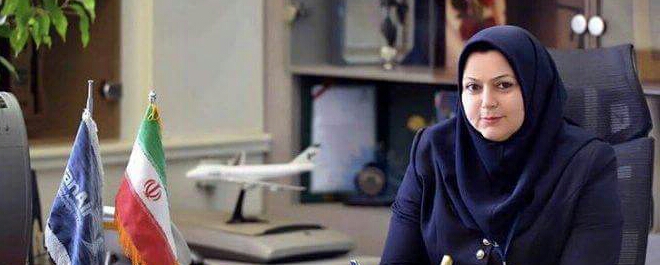Tehran:Women in Iran broke another glass ceiling when Iran Air’s first female Chief Executive Officer, Farzaneh Sharafbafi officially took charge of the country’s flag carrier company. The of first Iranian woman to receive a PhD in aerospace, she has been a board member at Iran Air, otherwise known as Homa.
“I hope I will be able to save the face of women in the aviation industry and make them proud,” she told the Financial Tribune on the sidelines of a formal ceremony held on the occasion of her taking office in Homa headquarters.
Addressing a crowd of government officials, Homa managers and reporters, she said Iran Air should “boost capabilities to be able to utilize the existing fleet in the best possible way.”
Among her plans, she referred to “a comprehensive renovation and restructuring of Homa”, including the hierarchical and technical structures as well as the company’s wage payment system; and also improvement of its management regarding quality, safety and security.
She said she would “improve the quality of Iran Air’s services to give the company a competitive edge in regional and global scale … through cooperation with prominent global aviation companies …, ICAO and IATA.”
During the ceremony, the company bid farewell to Farhad Parvaresh who led the airline for more than eight years, a period he described as the hardest years for the flag carrier.
His term coincided with the toughest international sanctions on Iran’s financial transactions, as well as tight international restrictions imposed on Homa. And those came as the company was already subject to general unilateral embargoes imposed by the United States since 1979.
In the late 1970s, Homa used to be an unrivaled airline in the Middle East in terms of profitability and the second safest airline in the world. The airline was launched in 1961, following a merger between Iranian Airways—founded by private investors in the 40s—and Persian Air Services.
Shortly after the Islamic Revolution, Iran Air lost access to new planes, manuals, spare parts and services from global plane makers. As its fleet aged it lost international routes to emerging airlines in Turkey and Persian Gulf states.
But as the sanctions were toughened amid escalated tensions over Iran’s nuclear program in 2010, the airline faced safety inspections by the European Aviation Safety Agency and some of its planes were banned from flying in EU airspace; though the EU denied the measure was related to the sanctions.
Moreover, as of 2010, Homa’s planes were subject to a refueling ban in many major European airports. Planes had to land in a third country to refuel on their way home from a visit to Europe. This effectively increased flight costs and led to significant delays.
Addressing the ceremony, Parvaresh said up to 60 of the company’s European bank accounts were shut after 2010, and the company had to carry cash to make and receive payments.
These restrictions were eased after the nuclear crisis came to an end.A landmark deal between Iran and the world powers was signed in 2015, and went into effect in January 2016, to grant Iran a relief from sanctions in exchange for limits on the country’s nuclear program.
The flag carrier secured massive orders from giant plane manufacturers afterwards. Its orders include 100 Airbus, 80 Boeing and 20 ATR passenger planes, with an aggregate value of $20-30 billion, based on Iranian estimates. The list prices top $30 billion.
Iran has so far been delivered seven aircraft. The three Airbus and four ATR planes have all been financed by their manufacturers. Airbus and ATR have agreed to finance a few more.
However, the prospects of financing the rest of the planes are still murky, as major European banks and big financial institutions are still hesitant to engage with Iran fearing US penalties.
Speaking to the Financial Tribune after the Sunday ceremony, head of Iran Civil Aviation Organization Ali Abedzadeh said Iran and the planemakers have yet to figure out a financing solution.
“Talks are still in progress,” he said, adding financing issues should be resolved before Iran Air receives the rest of the planes.
As part of the plane deals, 32 aircraft are scheduled to land in Iran by the end of 2018. Those include 16 turboprop ATR planes, five of them are to be delivered by the end of December and the rest in 2018.
According to the deputy minister of roads and urban development Asghar Fakhrieh-Kashan, Iran hopes to resolve the financing issues by putting out a tender, in which 10 companies from Japan, Norway, Denmark, China, Ireland and Britain have already expressed readiness.
The Iranian carrier is scheduled to receive four Airbus A320s by the yearend, five of the European planemaker’s A321s and four A330s next year. Three Boeing 737 deliveries are also planned in 2018.
The financing of the planes will be a challenge for Iran Air’s newly appointed CEO.
But even when the financing deals are finalized, there are other major steps Iran Air should take to optimize its revenues from the new jets.
While Homa has acquired a handful of new jets, this now needs to be matched with new routes and greater connectivity and codeshare pacts so that travelers have more options beyond Iran Air’s current network.
Moreover, alongside attempts to renew its aging fleet, officials are considering listing the company on both Tehran Stock Exchange and international equity markets. However, an outdated and uneconomical structure is tying their hands for the time being.
According to Minister of Roads and Urban Development Abbas Akhoundi, the airline plans to meet international standards through enhanced management and training to pave the way for its privatization.
There is a major hurdle pertaining to Iran Air’s pension fund, which accounts for a sizable portion of the carrier’s costs. The government is working to resolve this issue within six months.
Parvaresh said on Sunday that his company paid 3.85 trillion rials (more than $1 billion) in salaries during the eight years of his management. “Of this amount 1.15 trillion ($304 million) pertained to the retired employees.”
“Homa’s problems are manifold,” he said. “Ms. Sharafbafi will need help. I’m asking everyone to help her.”



